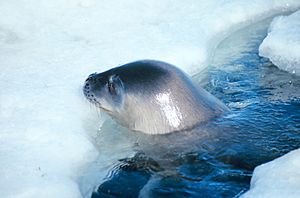North-west White Island Antarctic Specially Protected Area facts for kids
The North-west White Island Antarctic Specially Protected Area is a very special place in Antarctica. It covers about 142 square kilometers (55 square miles) of ice near White Island. This area is part of the Ross Archipelago, a group of islands in the icy continent of Antarctica.
This place is protected because it's home to a unique group of Weddell seals. These seals are super special for a few reasons. First, they live further south than any other known Weddell seal population in the world! Second, they are completely cut off from other seal groups. Giant ice shelves, like the McMurdo and Ross ice shelves, have grown so much that they trap these seals in their own icy world.
Scientists first saw seals here in 1958. Since then, their numbers have slowly grown to about 25 to 30 seals. These seals use the open water in McMurdo Sound to hunt and live. However, they can't swim under the 20 kilometers (12 miles) of thick, permanent ice to reach the open ocean. Their lungs just aren't big enough to hold their breath for that long!
Contents
Protecting Antarctic Seals: The North-west White Island Area
This special area is called an Antarctic Specially Protected Area (ASPA 137). This means it's a place that needs extra care and protection. The rules for ASPAs help keep important wildlife and environments safe.
What is an Antarctic Specially Protected Area?
An Antarctic Specially Protected Area, or ASPA, is like a nature reserve in Antarctica. These areas are set aside to protect unique plants, animals, or important historical sites. Scientists and visitors need special permits to enter an ASPA. This helps make sure that human activities don't harm the delicate Antarctic environment. The rules for each ASPA are very strict to keep these places safe for the future.
Where is This Special Place?
The North-west White Island ASPA is located in the icy continent of Antarctica. Specifically, it's on the north-west side of White Island. White Island is part of the Ross Archipelago, which is a group of islands found in the Ross Sea. This area is known for its extreme cold and stunning icy landscapes. The seals here live near the edge of the McMurdo Sound, which is a body of water in the Ross Sea.
Why Are These Seals So Special?
The Weddell seals living in this protected area are truly unique. They are the most southerly group of Weddell seals known anywhere on Earth. What makes them even more special is their isolation. Over time, massive ice shelves have expanded, completely surrounding this seal population. This means they can't travel to other parts of the ocean or meet other seal groups. They are stuck in their own icy home. This isolation makes them a very important group for scientists to study.
How Do the Seals Survive Here?
These amazing seals have adapted to their icy home. They use the open water in McMurdo Sound to find food and breathe. Weddell seals are known for their incredible diving abilities. They can hold their breath for a long time and dive deep to hunt fish and other sea creatures. However, even with their amazing lung capacity, they can't swim under the 20 kilometers (12 miles) of permanent ice that separates them from the open ocean. This means they rely on the cracks and openings in the ice within McMurdo Sound to survive.
A Growing Population
When scientists first discovered seals in this area in 1958, there were only a few. Over the years, the population has slowly increased. Today, there are typically between 25 and 30 Weddell seals living in this isolated area. This growth shows that the seals are managing to survive and reproduce in their unique, icy environment. Protecting this area helps ensure that this special population of Weddell seals can continue to thrive.


